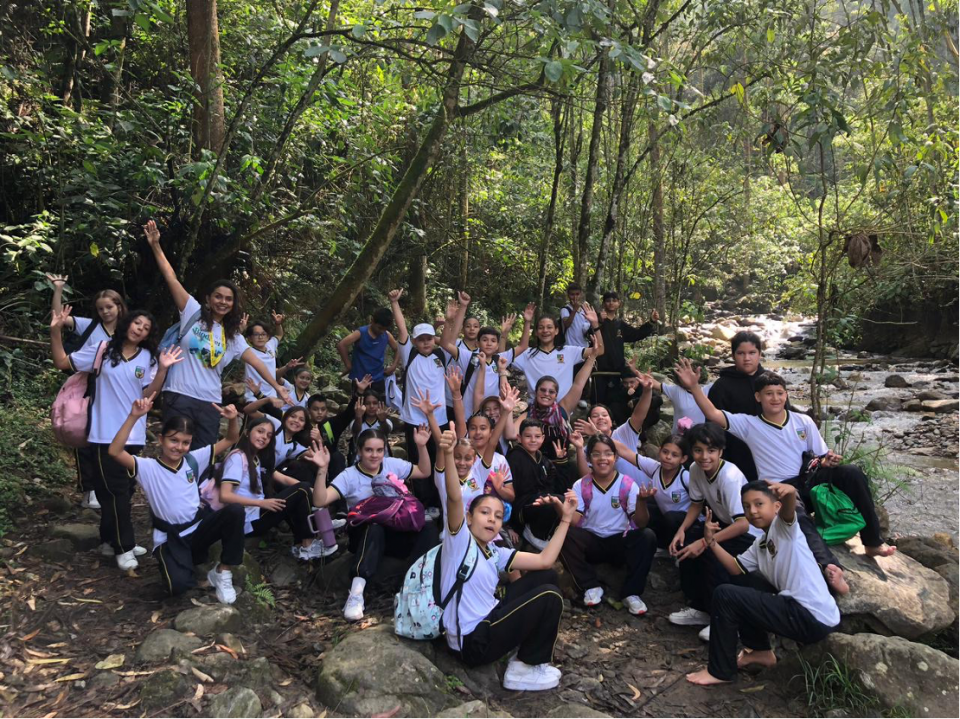
The municipality of Envigado (Antioquia, Colombia) is part of the metropolitan area of the Aburrá Valley, which is made up of ten municipalities including Medellín. Envigado has 242,000 inhabitants in a territory of 79.86 km2 comprising urban and rural areas.
Territorial planning and urban development, as well as agricultural and livestock activities, extend between the banks of the Medellín River and the slopes of the Aburrá Valley, putting pressure on green areas and the ecological structure of the city. The area of Envigado includes forests and protected ecosystems with high biodiversity, including biological corridors and species listed on the International Union for Conservation of Nature (IUCN) Red List.
This case study was delivered as part of INTERLACE: an EU-funded project to strengthen urban ecosystem restoration in the European Union and Latin America.
Through its participation in INTERLACE, Envigado aimed to improve environmental and development policies and create a network of communities to exchange knowledge and practices on the consolidation of ecological structure, ecosystem restoration and nature-based solutions. As a leading municipality in the department of Antioquia in terms of municipal management of protected areas, Envigado aims to serve as a model for other municipalities and regions on managing and strengthening the ecological structure.
Key aims:
- Preserve the Envigado Local System of Protected Areas (SILAPE), which covers 40% of the territory.
- Improve people's quality of life through the management of urban protected areas that contribute to community well-being, providing green spaces for mental and physical health.
- Promote proper management and valuation of water resources through environmental education processes, restoration, and recovery of the municipality's water bodies, crucial in the context of climate change.
- Increase green infrastructure through the Envigado Florece process, which seeks to expand by changing hard surfaces to soft surfaces, and implementing and enriching urban gardens.
Envigado recognizes the importance of NbS that address environmental and socio-economic challenges, which help generate resilience in the city. The use of the NbS concept is particularly important for Envigado, as it allows integrating and valuing these actions within an internationally recognized framework. This facilitates the communication of its efforts, collaboration with other entities, and the possibility of accessing global resources and knowledge to strengthen the conservation of the high biodiversity levels of the city and the sustainable development initiatives. The NbS implemented in Envigado are essential for the conservation, protection, and sustainable management of its natural resources.
As part of the INTERLACE project, Envigado has developed different activities and products that have contributed to the awareness and implementation of NbS in the city across different stakeholder groups. Some of these outputs are summarised below.
Governance instruments. The project has strengthened SILAPE Management Plan (Envigado Local System of Protected Areas), a strategy that conserves 40% of the territory for disaster prevention, climate change adaptation, biodiversity conservation, ecosystem services provision, and regional integrity, through the maintenance of connectivity and functionality of surrounding forests. The Plan is a crucial tool for providing a solid and effective management framework for the administration of these areas, as it constitutes the technical basis for the next Land Use Plan (POT) in 2025, establishing clear and forceful guidelines for effective conservation over the next 12 years, ensuring the protection of Envigado's biodiversity and ecological structure.
The Management Plan contains a diagnosis of the current condition of the SILAPE areas, a management proposal based on zoning, and rules for the use of natural resources and the development of permitted activities. The plan is accompanied by a biodiversity policy, the primary objective of which is to enhance natural resources through restoration, preservation, and sustainable use measures. This policy is framed within a 12-year action plan, which ensures its continuity and sustainability across different municipal administrations.
The third governance instrument implemented by the project is the Yurá Table (for the Envigado municipality stream), establishing a water governance table with the participation of municipal government representatives and community members. Its purpose is to promote and develop actions that consolidate the recognition of the La Ayurá stream as a component of natural and cultural importance, constituting it as an ecosystem heritage of high value for the municipality. This instrument unites efforts and leverages the diverse expertise of its members to address the La Ayurá stream from multiple perspectives, implementing environmental education activities in schools adjacent to the stream, and promoting artistic and cultural actions.
Engagement, education and awareness raising. Recognizing the urgent need to revalue the La Ayurá stream and restore its natural, cultural, and symbolic importance, the municipality of Envigado proposed this water corridor as an NbS. Through INTERLACE, various technical activities were implemented and accompanied by engagement, capacity building, education and awareness raising processes, such as:
- Guardians of the Ayurá: The INTERLACE project has supported several of the environmental education actions carried out by the Envigado Environmental Secretariat. The group of children and young people "Guardians of the Ayurá" was formed to train children from educational institutions near or neighbouring the Ayurá stream, to identify and protect the natural elements in the territory that are part of their daily lives. This has involved educational workshops, tours and visits to the stream and the El Salado park, in which students pass through more than 11 stations of experiential knowledge and reinforcing the link between children and the stream. The process has had an impact on more than 200 children and 6 educational institutions.
- SILAPE KIDS is a process that started in 2023, with a pilot test in an educational institution in the municipality of Envigado close to SILAPE. Five workshops were given to children to raise awareness about the knowledge and protection of the current protected areas in the municipality of Envigado. Workshop topics included ecological connectivity, mapping, biodiversity, importance of water and a final experiential workshop learning about the different rural and urban protected areas in the municipality.
- Learning about NbS by playing Minecraft: workshops using the Minecraft video game were held to help students learn about, plan, and design NbS aimed at sustainably managing the territory in harmony with water resources. As part of this initiative, a 3 km² portion of Envigado was recreated in a virtual Minecraft map. This pilot project aimed to teach territorial planning and NbS with a focus on water conservation. From this pilot test, work continued to articulate this initiative with the Secretary of Education of the Municipality, in order to incorporate this tool formally into school teaching in the Municipality's public institutions. More more than 150 children were involved.
Co-creation and awareness raising around the Envigado Monitoring Strategy. In March 2023, a face-to-face workshop was held with key community stakeholders and members of the Secretariat for the Environment to consider the challenges to be monitored and, from there, virtual meetings were held to discuss the possible indicators for each challenge. This work has served as inspiration for the improvement of the programme, in which emphasis is now placed on the implementation of functional gardens with native species to increase biodiversity.
Accompanying the strategy, competitions were held within the community. In 2022, the Secretary of the Environment reproduced a total of 80,866 plants and delivered a total of 36,745 of them for the enrichment of the gardens and green public spaces of the municipality.
The INTERLACE Envigado project has been successful in strengthening the SILAPE Management Plan (Envigado Local System of Protected Areas) and formulating a biodiversity policy to enhance natural resources through restoration, preservation and sustainable use measures. The project has engaged several hundred young people through the Guardians of the Ayurá scheme, raising awareness and understanding of topics including water, cartography, biodiversity, protected areas and land use planning in connection with NbS. It has also co-created a monitoring strategy with local communities and hosted knowledge-sharing events, including the conference Cities for Nature: Rethinking Urban-Rural Links for People and Biodiversity.
Key impacts include:
- Public engagement in co-producing and promoting ownership of nature-based solutions
- Increased capacity of local government to implement integrated and ecologically coherent urban planning and governance approaches
- Raised awareness and understanding of the benefits of healthy (peri)urban ecosystems for social, cultural and economic wellbeing
- Strengthened cooperation between European and CELAC communities of practice on (peri)urban ecological restoration and rehabilitation
- Participation in European and CELAC city and regional networks to inspire and support learning and exchange on restorative NBS
Most if not all of the methods used in Envigado are transferrable to other cities working on the topic of urban ecosystem restoration.
- Working with diverse stakeholders adds tangible benefits to the design and implementation of nature-based solutions in terms of ideation and planning, and notably in terms of ownership.
- Innovative approaches to engagement not only benefit education and understanding, but also empower communities to actively participate in shaping sustainable urban futures. These approaches have helped to foster a stronger connection between people, places and nature - and their interdependencies.
- Art and gamification have proven to be powerful tools for working with young people. The quality of ideas from young people has been exceptional, varying with age but consistently innovative and imaginative.
- Significant value can be gained from EU-CELAC collaboration in responding to the common challenges of climate change and biodiversity loss. Many of the governance instruments and public engagement methods are transferrable or otherwise easily adapted between regions.
This project has received funding from the European Union’s Horizon 2020 research and innovation programme under grant agreement No. 869324.



